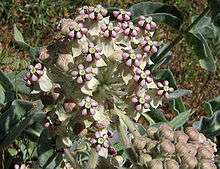Asclepias eriocarpa
Asclepias eriocarpa is a species of milkweed known by the common names woollypod milkweed, Indian milkweed, and kotolo.
| Asclepias eriocarpa | |
|---|---|
 | |
| Scientific classification | |
| Kingdom: | Plantae |
| Clade: | Tracheophytes |
| Clade: | Angiosperms |
| Clade: | Eudicots |
| Clade: | Asterids |
| Order: | Gentianales |
| Family: | Apocynaceae |
| Genus: | Asclepias |
| Species: | A. eriocarpa |
| Binomial name | |
| Asclepias eriocarpa | |
| Synonyms | |
|
Asclepias fremontii | |
Description
Asclepias eriocarpa is an erect perennial herb which is usually coated in a thick layer of white hairs. The leaves are lance-shaped to oval, rippled, and arranged oppositely in pairs or in whorls of 3 or 4. The inflorescence is a large umbel-like cluster of flowers. Each flower is white to cream and usually tinted with bright pink. It has a central array of rounded hoods and a corolla reflexed against the stalk. The fruit is a large, woolly follicle.
Distribution
Asclepias eriocarpa is native to California and adjacent parts of Nevada and Baja California, where it grows in many habitat types, especially dry areas.
Uses
The plant was used as a source of fiber and medicine by several California Indian groups, including the Ohlone and Luiseño.[1] The Concow tribe calls the plant bō'-kō (Konkow language).[2]
Ecology
Asclepias eriocarpa is a specific monarch butterfly food and habitat plant. It is one of the most poisonous milkweeds. Natural History July/August 2015 calls it the most poisonous, but most sources put it below A. lancifolia. No source found, said whether the toxicity is due to high levels of cardioactive glycosides, or to the presence of a neurotoxic resin which some milkweeds produce in addition to the glycosides.
References
- Ethnobotany
- Chesnut, Victor King (1902). Plants used by the Indians of Mendocino County, California. Government Printing Office. p. 404. Retrieved 24 August 2012.